Sand- and Clay-Photocured-Geomembrane Interface Shear Characteristics Using Direct Shear Test
Abstract
:1. Introduction
2. Principle of Photocuring Reaction
3. Materials and Processes for Manufacturing Photocured Geomembrane
3.1. Materials
3.2. Material Production Procedure
4. Direct Shear Tests
5. Test Results and Analysis
5.1. Measured Shear Stress-Displacement Response
5.2. Interface Shear Stress Peak Analysis
5.3. Interfacial Friction Coefficient
6. Conclusions
- (1).
- For the photocured geomembrane –clay interface, the interface shear stress peak of the geomembrane with a 4% photoinitiator is the largest under the normal stress of 50 kPa. Under the normal stress of 300 kPa, the peak value of the interfacial shear stress of the geomembrane with a 2% photoinitiator is the largest. In the anti-seepage system, it is more reasonable to choose a geomembrane with a 2% photoinitiator.
- (2).
- For the photocured geomembrane–sand soil interface, the interface shear stress peak value of the geomembrane with a 5% photoinitiator is the largest under the normal stress of 50 kPa. Under the normal stress of 300 kPa, the peak value of the interfacial shear stress of the geomembrane with a 4% photoinitiator is the largest. At the boundary between the drainage layer and the anti-seepage layer of the landfill, it is more reasonable to choose a 4% photoinitiator geomembrane. In the capping system, it is preferable to choose a 5% photoinitiator geomembrane.
- (3).
- For the photocured geomembrane–clay/sand interface, the interface friction coefficient shows a trend of first increasing and then decreasing with the increase of normal stress. When the normal stress reaches the critical normal stress, the interface friction coefficient will increase slowly. For the photocured geomembrane–sand soil interface, the geomembrane interface of 2% photoinitiator shows a trend that the interface friction coefficient decreases with the increase of normal stress. The photot-cured geomembranes of other ratios all show a trend of first increasing and then decreasing with the increase of normal stress.
- (4).
- The shear strength of the interface between photocured geomembrane and clay/sand is mainly determined by the interface friction angle. The friction angle of photocured geomembrane–sand soil is larger than photocured geomembrane–clay. Therefore, the interface between the photocured geomembrane and sand has better shear resistance and tensile crack resistance.
Supplementary Materials
Author Contributions
Funding
Institutional Review Board Statement
Informed Consent Statement
Data Availability Statement
Acknowledgments
Conflicts of Interest
References
- Zhao, W. Geosynthetics; Machinery Industry Press: Beijing, China, 2005. (In Chinese) [Google Scholar]
- Chao, X.; Haofeng, X. Geosynthetics, 1st ed.; Machinery Industry Press: Beijing, China, 2010. (In Chinese) [Google Scholar]
- Anonymous. Research and Markets: A Guide to Polymeric Geomembranes: A Practical Approach Offers an Informed Overview of the Developments in the Field. M2 PressWIRE 2009, 158, 260–265. [Google Scholar]
- Ingold, T.S. Geosynthetics: Applications, design and construction proceedings of the first European geosynthetics conference-EUROGEO 1. Geotext. Geomembr. 1996, 14, 13–18. [Google Scholar] [CrossRef]
- Stansbury, J.W.; Dickens, S.H. Determination of double bond conversion in dental resins by near infrared spectroscopy. Dent. Mater. 2001, 17, 71–79. [Google Scholar] [CrossRef]
- Arica, Y.; Hasirci, V.N. Immobilization of glucose oxidase in poly(2–hydroxyethyl methacrylate) membranes. Biomaterials 1987, 8, 489–495. [Google Scholar] [CrossRef]
- Arica, M.Y.; Denizli, A.; Salih, B.; Piskin, E.; Hasirc, V. Catalase adsorption onto Cibacron Blue F3GA and Fe(III)-derivatized poly(hydroxyethyl methacrylate) membranes and application to a continuous system. J. Membr. Sci. 1997, 129, 65–76. [Google Scholar] [CrossRef]
- Fleming, I.R.; Sharma, J.S.; Jogi, M.B. Shear strength of geomembrane–soil interface under unsaturated conditions-ScienceDirect. Geotext. Geomembr. 2006, 24, 274–284. [Google Scholar] [CrossRef]
- Punetha, P.; Mohanty, P.; Samanta, M. Microstructural investigation on mechanical behavior of soil-geosynthetic interface in direct shear test. Geotext. Geomembr. 2017, 45, 197–210. [Google Scholar] [CrossRef]
- Feng, S.J.; Liu, X.; Chen, H.X.; Zhao, T. Micro-mechanical analysis of geomembrane-sand interactions using DEM. Comput. Geotech. 2017, 94, 58–71. [Google Scholar] [CrossRef]
- Junli, G.; Mengxi, Z.; Wenjie, Z. Interface property between sand and reinforced geomembrane. Rock Soil Mech. 2011, 32, 3225–3230. (In Chinese) [Google Scholar]
- Cen, W.J.; Bauer, E.; Wen, L.S.; Wang, H.; Sun, Y.J. Experimental investigations and constitutive modeling of cyclic interface shearing between HDPE geomembrane and sandy gravel. Geotext. Geomembr. 2019, 47, 269–279. [Google Scholar] [CrossRef]
- Rowe, R.K.; Yu, Y. Magnitude and significance of tensile strains in geomembrane landfill liners. Geotext. Geomembr. 2019, 47, 439–458. [Google Scholar] [CrossRef]
- Izgin, M.; Wasti, Y. Geomembrane-sand interface frictional properties as determined by inclined board and shear box tests. Geotext. Geomembr. 1998, 16, 207–219. [Google Scholar] [CrossRef]
- Gao, J.L.; Zhang, M.X.; Zhang, W.J. Interface frictional property between sand and geomembrane. In Advance Environment Geotechnics; Springer: Berlin/Heidelberg, Germany, 2010; pp. 822–827. [Google Scholar] [CrossRef]
- Koerner, R. Designing with Geosynthetics; Xlibris Corporation: Bloomington, IN, USA, 2012. [Google Scholar]
- Ling, H.I.; Pamuk, A.; Dechasakulsom, M.; Mohri, Y.; Burke, C. Interactions between PVC Geomembranes and Compacted Clays. J. Geotech. Geoenviron. Eng. 2001, 127, 950–954. [Google Scholar] [CrossRef]
- Gao, J.L.; Zhang, M.X.; Zhang, W.J. Interface Frictional Property Between Sand and Geomembrane. In Proceedings of the International Symposium on Geoenvironmental Engineering, Shanghai, China, 8–10 September 2009. [Google Scholar]
- Abramova, N.; Ipatov, A.; Levichev, S.; Bratov, A. Integrated multi-sensor chip with photocured polymer membranes containing copolymerised plasticizer for direct pH, potassium, sodium and chloride ions determination in blood serum. Talanta 2009, 79, 984–989. [Google Scholar] [CrossRef] [PubMed]
- Yuhai, X.; Schilling, C.; Arora, N.; Boydston, A.J.; Rudykh, S. Mechanical characterization and constitutive modeling of visco-hyperelasticity of photocured polymers. Addit. Manuf. 2020, 36, 101511. [Google Scholar] [CrossRef]
- Kim, M.; Song, C.; Han, D.K.; Ahn, K.D.; Hwang, S.S.; Ahn, D.J.; Kim, M.H. Allylimidazolium salt based antibacterial polymer coatings produced by thiol–ene photo-curing. React. React. 2015, 87, 53–60. [Google Scholar] [CrossRef]
- Mathias, L.J.; Kusefoglu, S.H.; Kress, A.O.; Lee, S.; Geiger, C.C. Multifunctional acrylate monomers, dimers and oligomers: Applications from contact lenses to wood, olymer composites. Macromol. Symp. 1991, 51, 153–167. [Google Scholar] [CrossRef]
- Shukla, S.R.; Athalye, A.R. Graft-copolymerization of glycidyl methacrylate onto cotton cellulose. J. Appl. Polym. Sci. 1994, 54, 279–288. [Google Scholar] [CrossRef]
- ASTM. Standard Test Method for Index Puncture Resistance of Geomembranes and Related Products; American Society for Testing and Materials: Philadelphia, PA, USA, 2013. [Google Scholar]
- ASTM. Standard Test Method for Tearing Strength of Fabrics by Falling-Pendulum (Elmendorf-Type) Apparatus; American Society for Testing and Materials: Philadelphia, PA, USA, 2009. [Google Scholar]
- Ministry of Housing and Urban-Rural Development of the People’s Republic of China. GB/T50123–2019 Standard for Geotechnical Test Methods; China Planning Press: Beijing, China, 2019. (In Chinese) [Google Scholar]
- Ministry of Housing and Urban-Rural Development of the People’s Republic of China. GB/T50290–2014 Technical Specifications for the Application of Geosynthetic Materials; China Planning Press: Beijing, China, 2014. (In Chinese) [Google Scholar]
- Frost, J.D.; Kim, D.; Lee, S.W. Microscale geomembrane-granular material interactions. J. Mater. Civ. Eng. 2011, 16, 79–92. [Google Scholar] [CrossRef]
- Frost, J.D.; Dove, J.E. Peak Friction Behavior of Smooth Geomembrane-Particle Interfaces. J. Geotech. Geoenviron. Eng. 1991, 125, 544–555. [Google Scholar] [CrossRef]
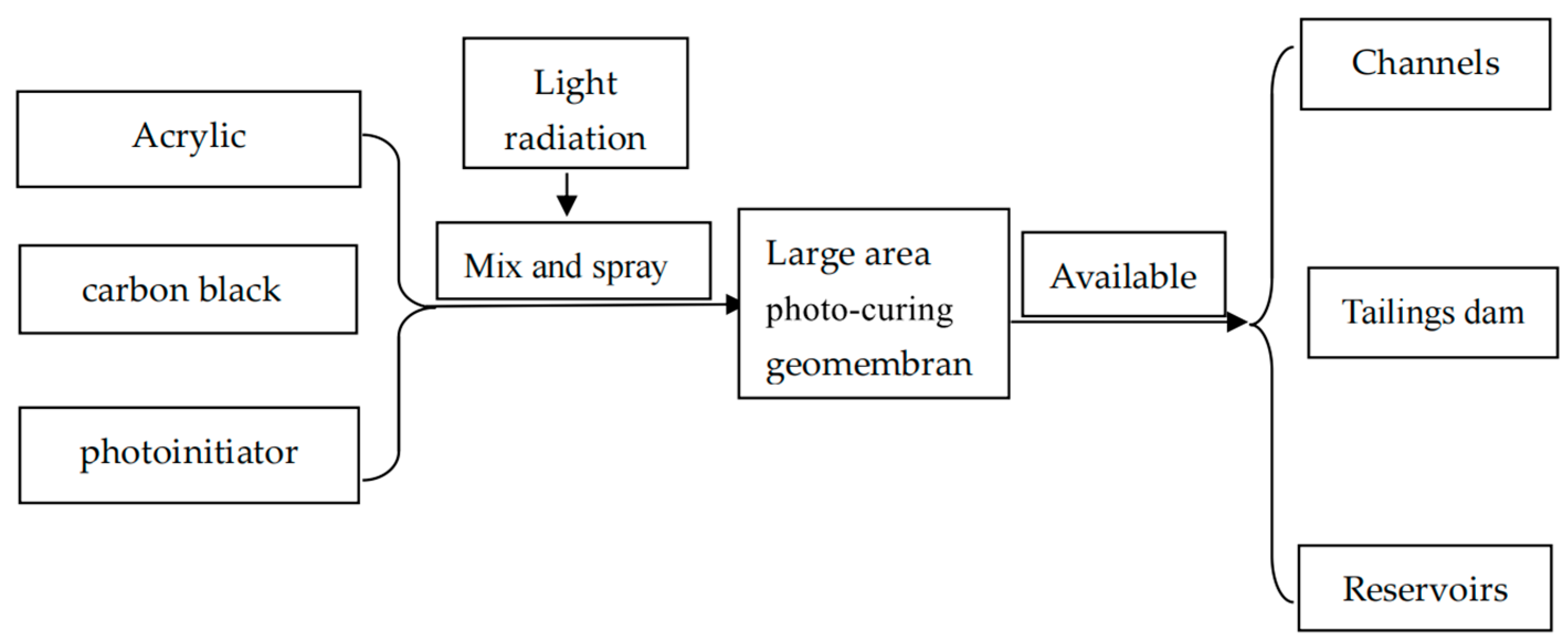



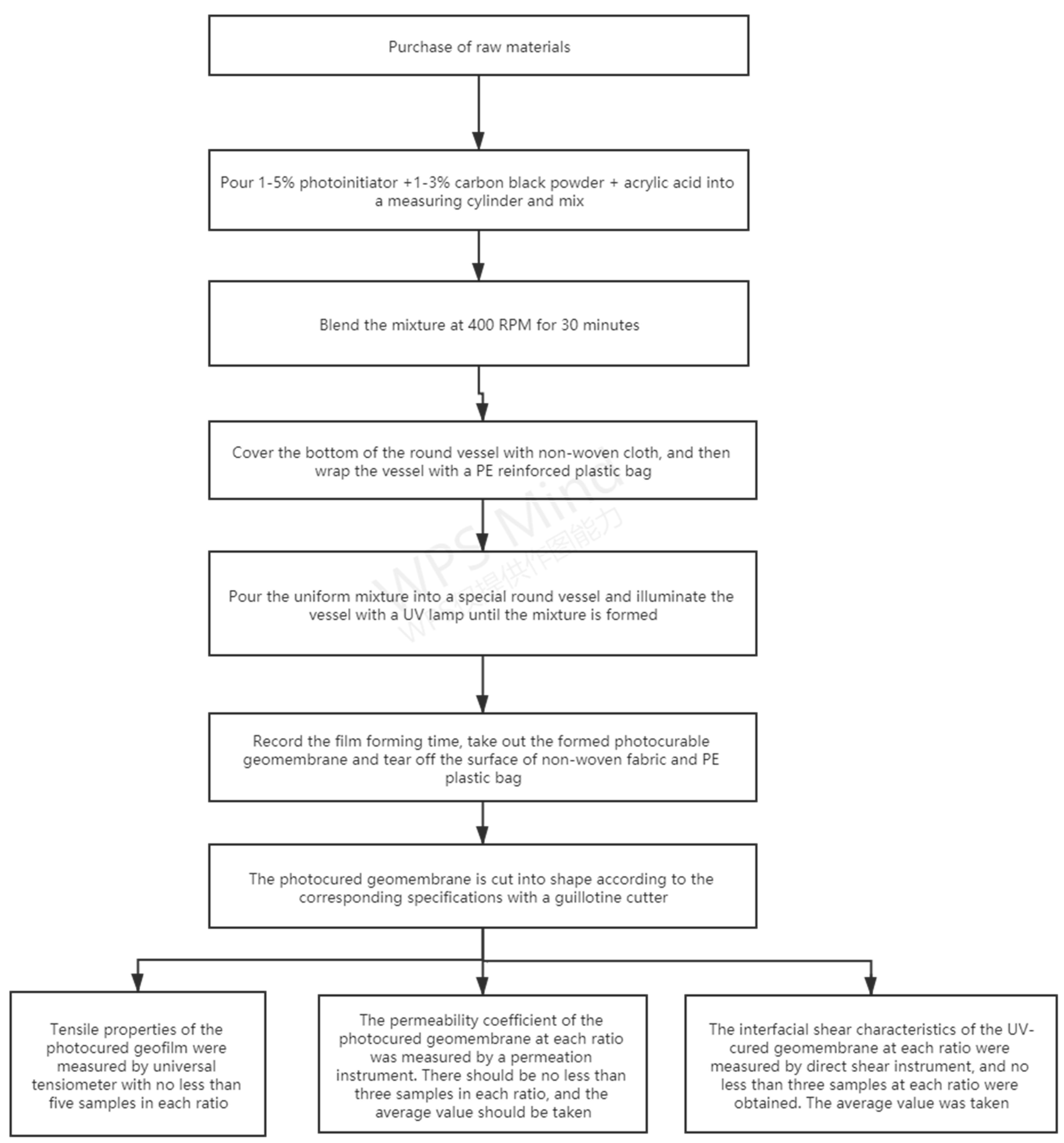
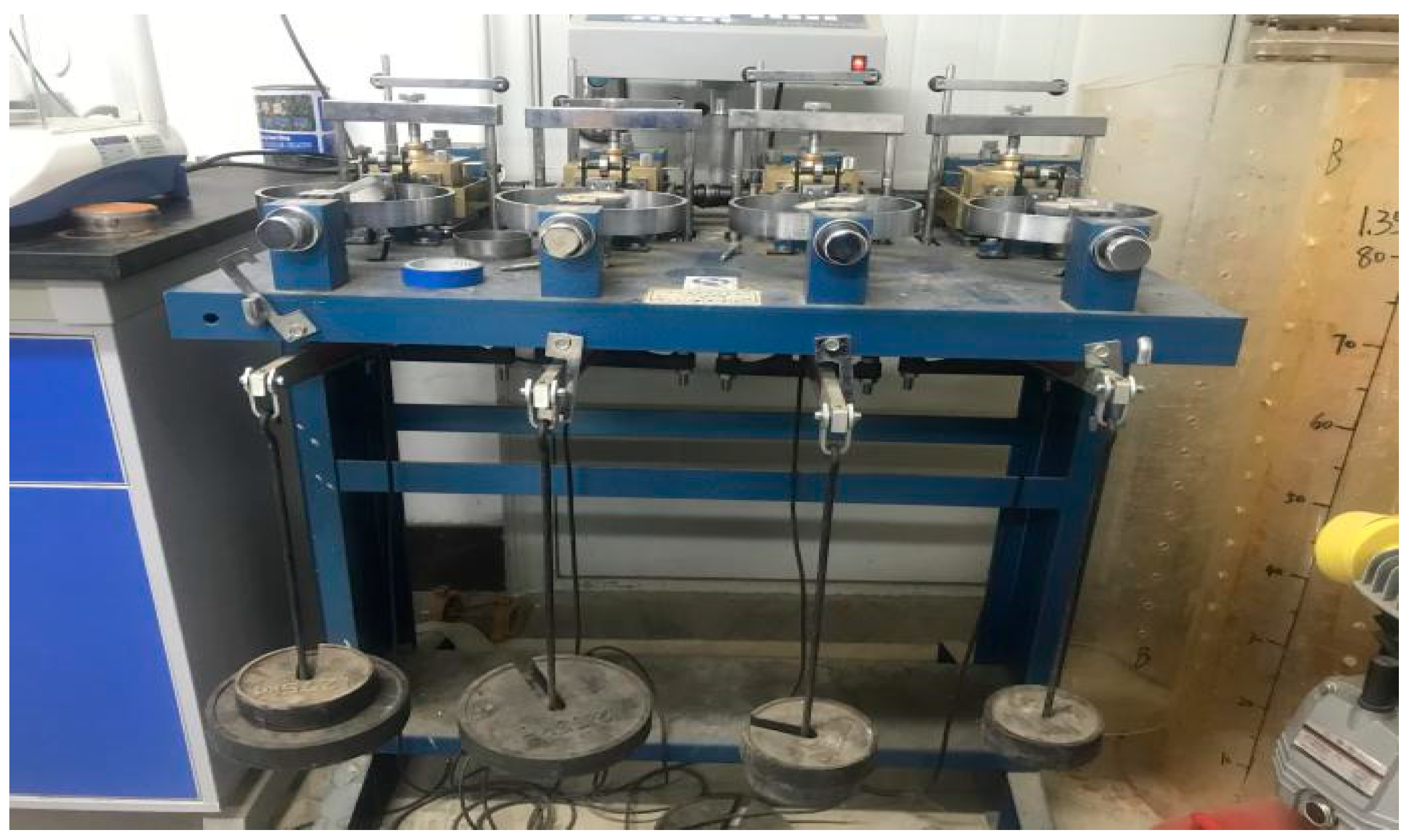
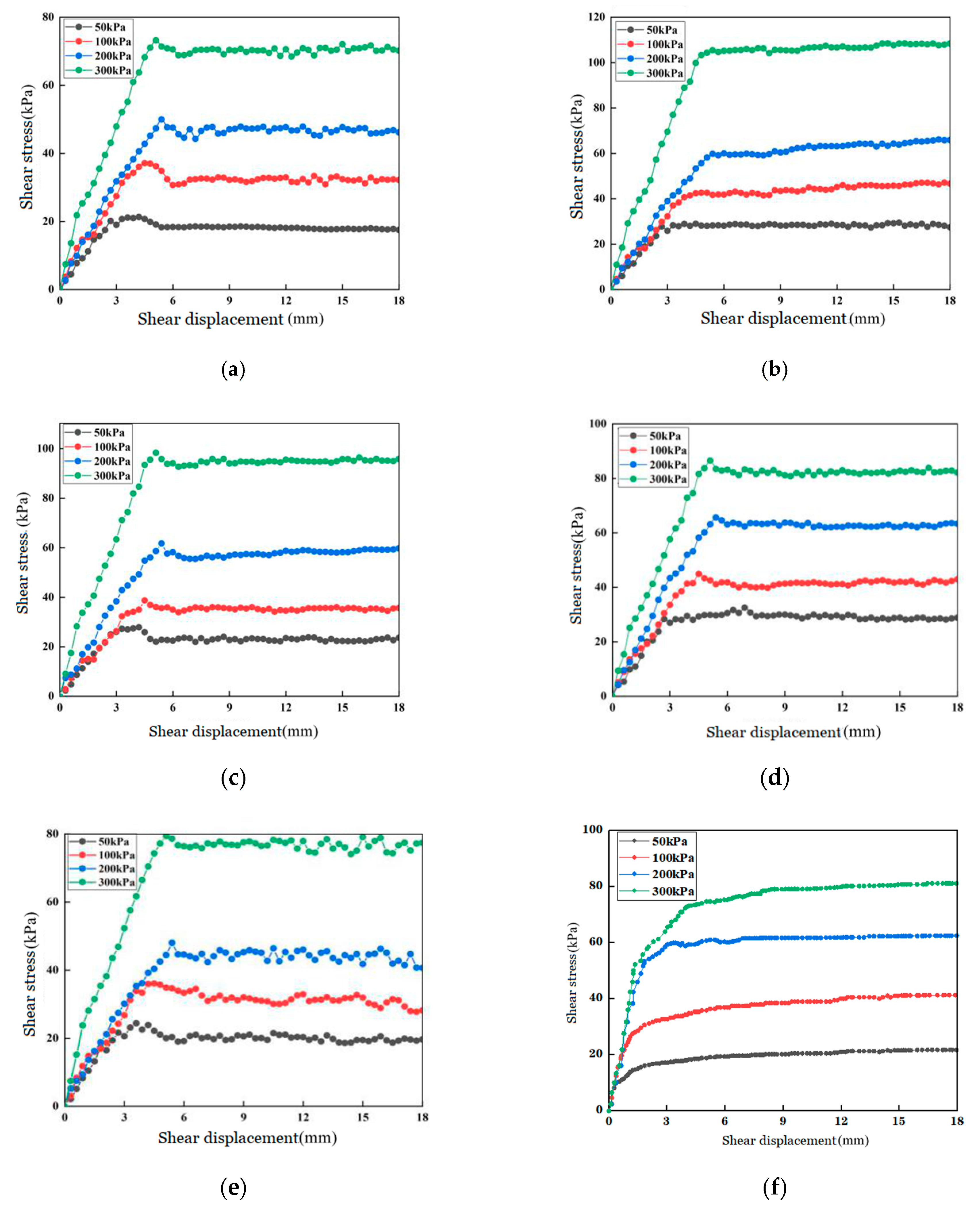
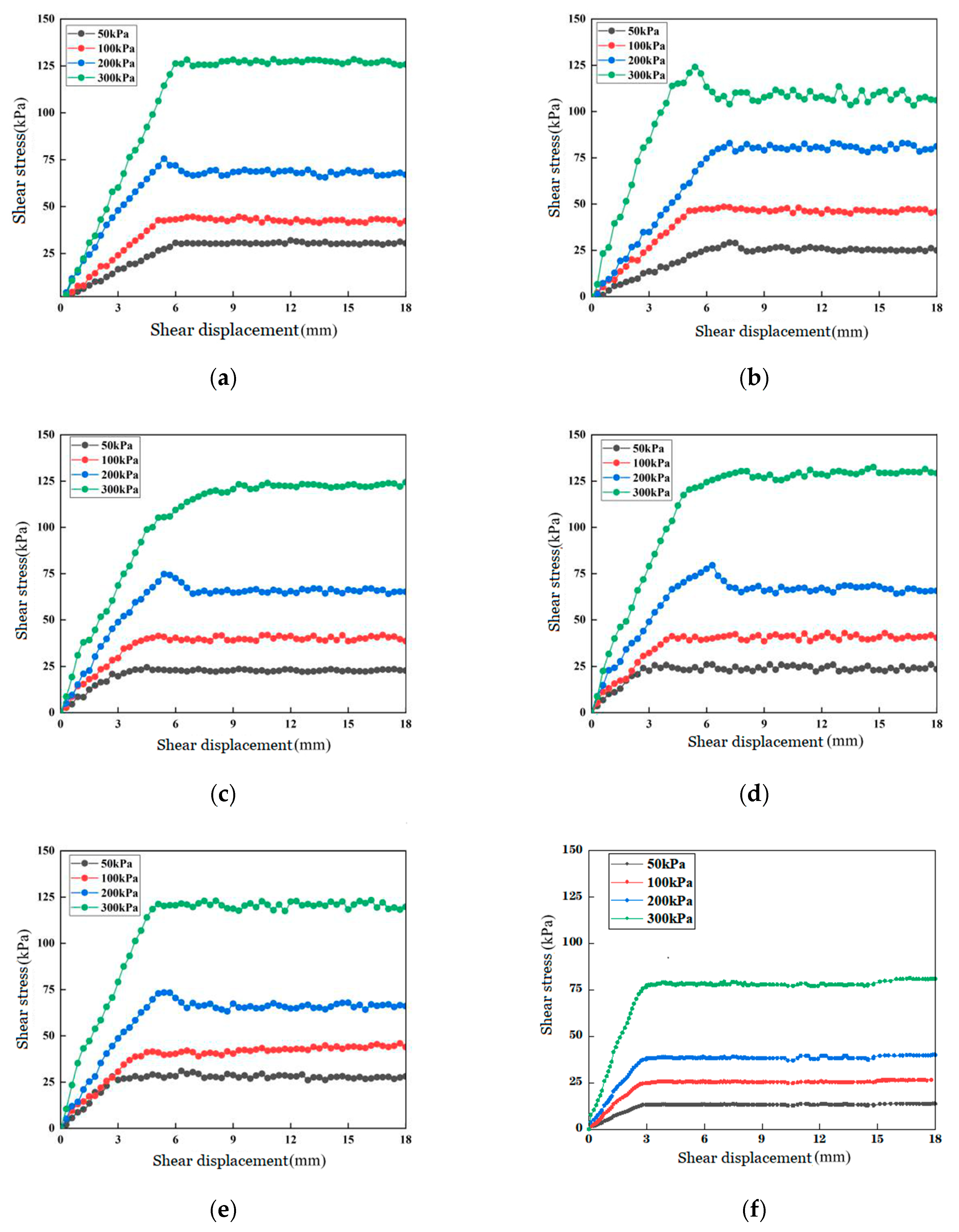
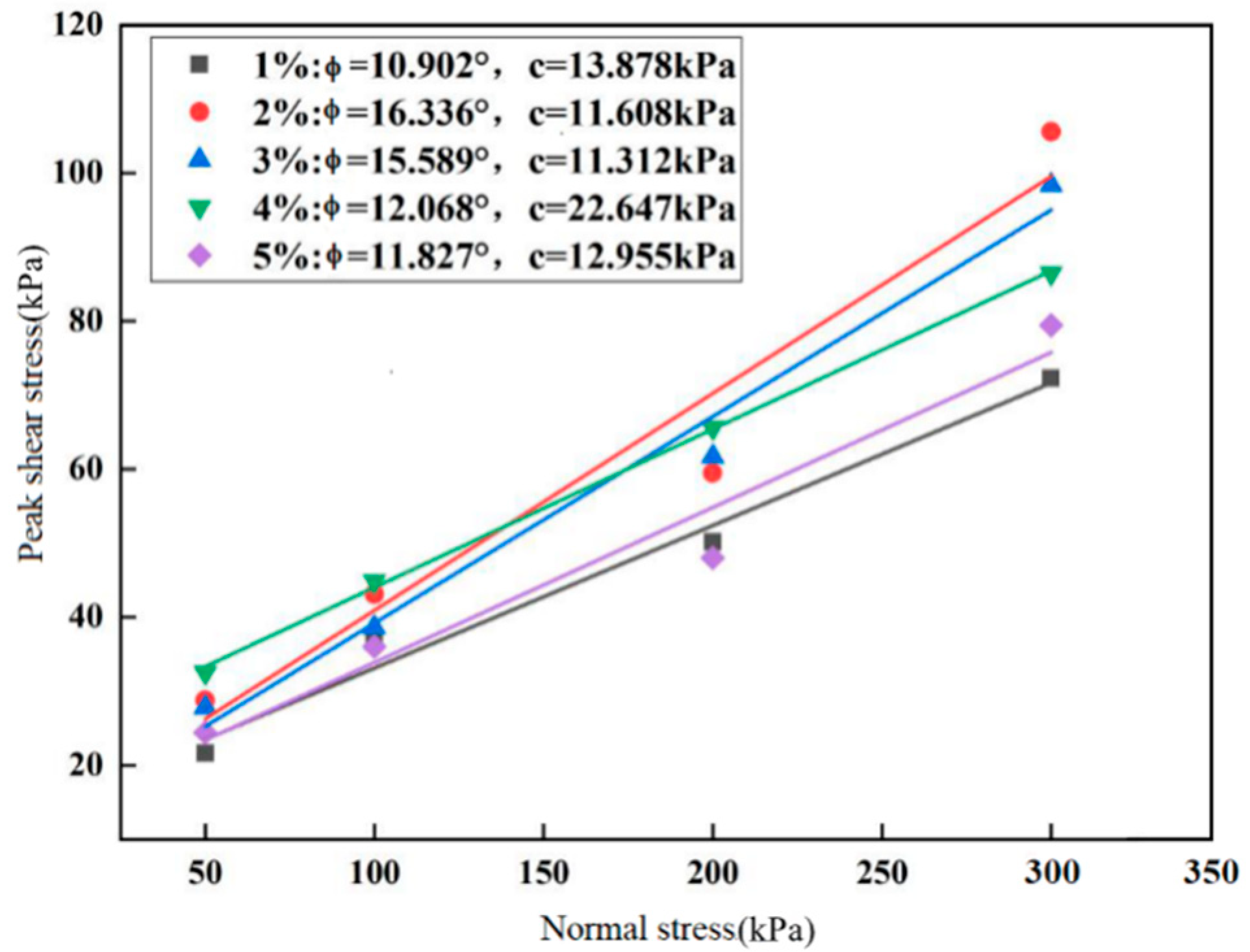

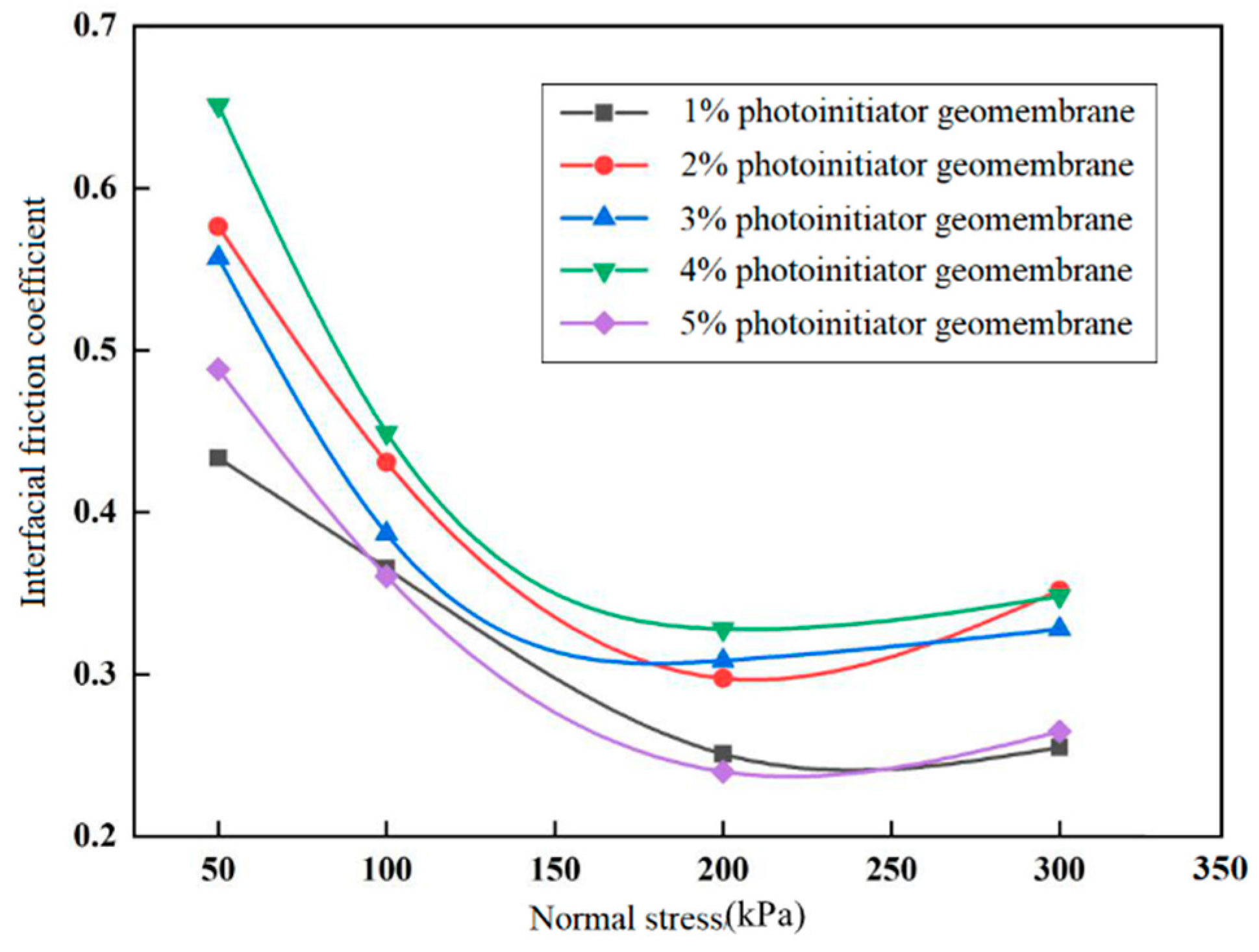

| Type of Materials Used in the Test | Specific Name | Percentage Range |
|---|---|---|
| Acrylic monomers | Acrylic monomers (CH2CHCOOH) | 90% |
| Photoinitiator | TPO Photoinitiator (C22H21P02) | 5% |
| Carbon black | High pigment 5000 mesh carbon black | 3% |
| Others | 2% |
| Sample Number | Carbon Black Content (%) | Photoinitiator Content (%) | Acrylic Monomers (%) |
|---|---|---|---|
| 1 | 2 | 1 | 97 |
| 2 | 2 | 2 | 96 |
| 3 | 2 | 3 | 95 |
| 4 | 2 | 4 | 94 |
| 5 | 2 | 5 | 93 |
| Characteristic Index | Value |
|---|---|
| Natural moisture content (%) | 7.71 |
| Specific gravity | 2.73 |
| Natural Density (g·cm−3) | 1.39 |
| Optimum moisture content (%) | 20.80 |
| Max dry density/(g·cm−3) | 1.62 |
| Liquid limit (%) | 34.00 |
| Plastic limit (%) | 17.80 |
| Photoinitiator Content (%) | Interfacial Shear Strength Coefficient (Compared with Clay) | Interfacials Shear Strength Coefficient (Compared with Sand) |
|---|---|---|
| clay/sand | 1 | 1 |
| 1 | 0.68 | 1.90 |
| 2 | 1.04 | 1.70 |
| 3 | 0.99 | 1.95 |
| 4 | 0.75 | 2.10 |
| 5 | 0.71 | 1.80 |
Publisher’s Note: MDPI stays neutral with regard to jurisdictional claims in published maps and institutional affiliations. |
© 2021 by the authors. Licensee MDPI, Basel, Switzerland. This article is an open access article distributed under the terms and conditions of the Creative Commons Attribution (CC BY) license (https://creativecommons.org/licenses/by/4.0/).
Share and Cite
Li, L.; Yan, H.; Xiao, H.; Li, W.; Geng, Z. Sand- and Clay-Photocured-Geomembrane Interface Shear Characteristics Using Direct Shear Test. Sustainability 2021, 13, 8201. https://doi.org/10.3390/su13158201
Li L, Yan H, Xiao H, Li W, Geng Z. Sand- and Clay-Photocured-Geomembrane Interface Shear Characteristics Using Direct Shear Test. Sustainability. 2021; 13(15):8201. https://doi.org/10.3390/su13158201
Chicago/Turabian StyleLi, Lihua, Han Yan, Henglin Xiao, Wentao Li, and Zhangshuai Geng. 2021. "Sand- and Clay-Photocured-Geomembrane Interface Shear Characteristics Using Direct Shear Test" Sustainability 13, no. 15: 8201. https://doi.org/10.3390/su13158201
APA StyleLi, L., Yan, H., Xiao, H., Li, W., & Geng, Z. (2021). Sand- and Clay-Photocured-Geomembrane Interface Shear Characteristics Using Direct Shear Test. Sustainability, 13(15), 8201. https://doi.org/10.3390/su13158201





